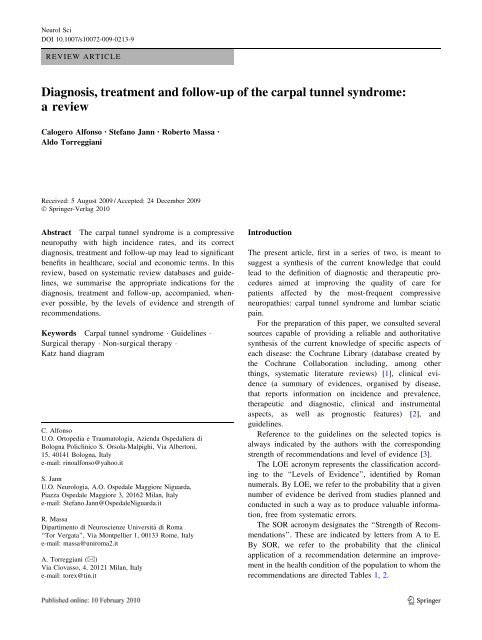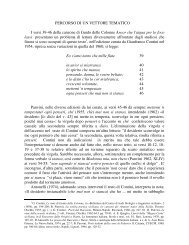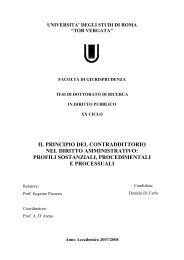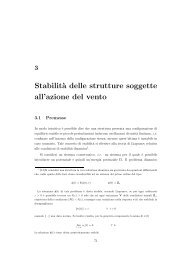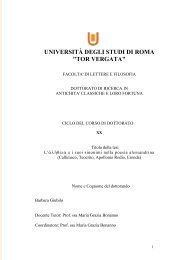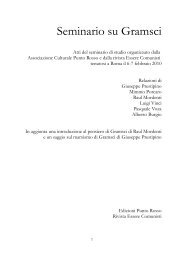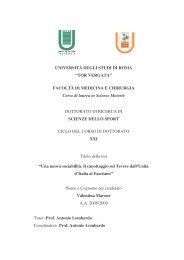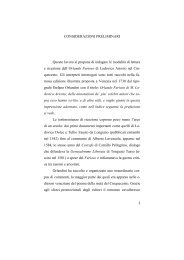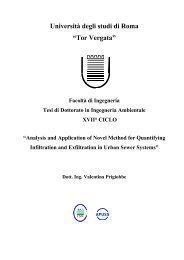Diagnosis, treatment and follow-up of the carpal ... - Home page | ART
Diagnosis, treatment and follow-up of the carpal ... - Home page | ART
Diagnosis, treatment and follow-up of the carpal ... - Home page | ART
You also want an ePaper? Increase the reach of your titles
YUMPU automatically turns print PDFs into web optimized ePapers that Google loves.
Neurol Sci<br />
DOI 10.1007/s10072-009-0213-9<br />
REVIEW <strong>ART</strong>ICLE<br />
<strong>Diagnosis</strong>, <strong>treatment</strong> <strong>and</strong> <strong>follow</strong>-<strong>up</strong> <strong>of</strong> <strong>the</strong> <strong>carpal</strong> tunnel syndrome:<br />
a review<br />
Calogero Alfonso • Stefano Jann • Roberto Massa •<br />
Aldo Torreggiani<br />
Received: 5 August 2009 / Accepted: 24 December 2009<br />
Ó Springer-Verlag 2010<br />
Abstract The <strong>carpal</strong> tunnel syndrome is a compressive<br />
neuropathy with high incidence rates, <strong>and</strong> its correct<br />
diagnosis, <strong>treatment</strong> <strong>and</strong> <strong>follow</strong>-<strong>up</strong> may lead to significant<br />
benefits in healthcare, social <strong>and</strong> economic terms. In this<br />
review, based on systematic review databases <strong>and</strong> guidelines,<br />
we summarise <strong>the</strong> appropriate indications for <strong>the</strong><br />
diagnosis, <strong>treatment</strong> <strong>and</strong> <strong>follow</strong>-<strong>up</strong>, accompanied, whenever<br />
possible, by <strong>the</strong> levels <strong>of</strong> evidence <strong>and</strong> strength <strong>of</strong><br />
recommendations.<br />
Keywords Carpal tunnel syndrome Guidelines<br />
Surgical <strong>the</strong>rapy Non-surgical <strong>the</strong>rapy<br />
Katz h<strong>and</strong> diagram<br />
C. Alfonso<br />
U.O. Ortopedia e Traumatologia, Azienda Ospedaliera di<br />
Bologna Policlinico S. Orsola-Malpighi, Via Albertoni,<br />
15, 40141 Bologna, Italy<br />
e-mail: rinoalfonso@yahoo.it<br />
S. Jann<br />
U.O. Neurologia, A.O. Ospedale Maggiore Niguarda,<br />
Piazza Ospedale Maggiore 3, 20162 Milan, Italy<br />
e-mail: Stefano.Jann@OspedaleNiguarda.it<br />
R. Massa<br />
Dipartimento di Neuroscienze Università di Roma<br />
‘‘Tor Vergata’’, Via Montpellier 1, 00133 Rome, Italy<br />
e-mail: massa@uniroma2.it<br />
A. Torreggiani (&)<br />
Via Ciovasso, 4, 20121 Milan, Italy<br />
e-mail: torex@tin.it<br />
Introduction<br />
The present article, first in a series <strong>of</strong> two, is meant to<br />
suggest a syn<strong>the</strong>sis <strong>of</strong> <strong>the</strong> current knowledge that could<br />
lead to <strong>the</strong> definition <strong>of</strong> diagnostic <strong>and</strong> <strong>the</strong>rapeutic procedures<br />
aimed at improving <strong>the</strong> quality <strong>of</strong> care for<br />
patients affected by <strong>the</strong> most-frequent compressive<br />
neuropathies: <strong>carpal</strong> tunnel syndrome <strong>and</strong> lumbar sciatic<br />
pain.<br />
For <strong>the</strong> preparation <strong>of</strong> this paper, we consulted several<br />
sources capable <strong>of</strong> providing a reliable <strong>and</strong> authoritative<br />
syn<strong>the</strong>sis <strong>of</strong> <strong>the</strong> current knowledge <strong>of</strong> specific aspects <strong>of</strong><br />
each disease: <strong>the</strong> Cochrane Library (database created by<br />
<strong>the</strong> Cochrane Collaboration including, among o<strong>the</strong>r<br />
things, systematic literature reviews) [1], clinical evidence<br />
(a summary <strong>of</strong> evidences, organised by disease,<br />
that reports information on incidence <strong>and</strong> prevalence,<br />
<strong>the</strong>rapeutic <strong>and</strong> diagnostic, clinical <strong>and</strong> instrumental<br />
aspects, as well as prognostic features) [2], <strong>and</strong><br />
guidelines.<br />
Reference to <strong>the</strong> guidelines on <strong>the</strong> selected topics is<br />
always indicated by <strong>the</strong> authors with <strong>the</strong> corresponding<br />
strength <strong>of</strong> recommendations <strong>and</strong> level <strong>of</strong> evidence [3].<br />
The LOE acronym represents <strong>the</strong> classification according<br />
to <strong>the</strong> ‘‘Levels <strong>of</strong> Evidence’’, identified by Roman<br />
numerals. By LOE, we refer to <strong>the</strong> probability that a given<br />
number <strong>of</strong> evidence be derived from studies planned <strong>and</strong><br />
conducted in such a way as to produce valuable information,<br />
free from systematic errors.<br />
The SOR acronym designates <strong>the</strong> ‘‘Strength <strong>of</strong> Recommendations’’.<br />
These are indicated by letters from A to E.<br />
By SOR, we refer to <strong>the</strong> probability that <strong>the</strong> clinical<br />
application <strong>of</strong> a recommendation determine an improvement<br />
in <strong>the</strong> health condition <strong>of</strong> <strong>the</strong> population to whom <strong>the</strong><br />
recommendations are directed Tables 1, 2.<br />
123
Table 1 Levels <strong>of</strong> evidence [3]<br />
I Evidence obtained from several r<strong>and</strong>omised controlled clinical<br />
trials <strong>and</strong>/or from systematic reviews <strong>of</strong> r<strong>and</strong>omised studies<br />
II Evidence obtained from a single r<strong>and</strong>omised trial with adequate<br />
design<br />
III Evidence obtained from cohort studies with concurrent or<br />
historical controls or from <strong>the</strong>ir meta-analysis<br />
IV Evidence obtained from retrospective case–control studies or<br />
from <strong>the</strong>ir meta-analysis<br />
V Evidence obtained from case studies (case series) without control<br />
gro<strong>up</strong><br />
VI Evidence based on <strong>the</strong> opinion <strong>of</strong> authoritative experts or expert<br />
committees as indicated in guidelines or consensus conferences,<br />
or based on opinions <strong>of</strong> <strong>the</strong> members <strong>of</strong> <strong>the</strong> working gro<strong>up</strong><br />
Table 2 Strength <strong>of</strong> Recommendations [3]<br />
A Performance <strong>of</strong> a given procedure or diagnostic test is highly<br />
recommended. Indicates a particular recommendation s<strong>up</strong>ported<br />
by scientific evidence <strong>of</strong> a good level, although not necessarily<br />
<strong>of</strong> levels I or II<br />
B Questions arise on <strong>the</strong> fact that a given procedure/intervention<br />
should always be recommended, <strong>and</strong> its performance must<br />
always be carefully taken into consideration<br />
C Considerable uncertainty exists in favour or against <strong>the</strong><br />
recommendation to perform a procedure or intervention<br />
D Performance <strong>of</strong> <strong>the</strong> procedure is not recommended<br />
E It is strongly recommended not to perform <strong>the</strong> procedure<br />
Compressive <strong>and</strong> entrapment neuropathies<br />
Compressive neuropathies are mononeuropathies or radiculopathies<br />
caused by mechanical distortion produced by a<br />
compressive force. In particular, we define entrapment<br />
neuropathy a chronic focal compressive neuropathy caused<br />
by a pressure increase inside specific unstretchable anatomical<br />
structures (channels) [4].<br />
When <strong>the</strong> nerve fibres are subjected to a mechanical<br />
force, demyelination <strong>of</strong> <strong>the</strong> paranodal region initially<br />
develops in <strong>the</strong> compression site, which <strong>the</strong>n spreads to<br />
<strong>the</strong> entire internodal segment. In this first phase, a block<br />
<strong>of</strong> nervous transmission occurs, caused by focal demyelination<br />
with intact axons (neuroapraxia). If <strong>the</strong> compression<br />
persists, blood flow to <strong>the</strong> endoneural capillary<br />
system may be interr<strong>up</strong>ted, leading to alterations in <strong>the</strong><br />
blood-nerve barrier, development <strong>of</strong> endoneural oedema,<br />
<strong>and</strong> onset <strong>of</strong> a vicious circle made <strong>of</strong> venous congestion,<br />
ischaemia <strong>and</strong> local metabolic alterations. This series <strong>of</strong><br />
events, if protracted in time, may lead to axonal<br />
degeneration, macrophage attraction <strong>and</strong> activation,<br />
release <strong>of</strong> inflammatory cytokines, nitric oxide, <strong>and</strong><br />
development <strong>of</strong> ‘‘chemical neuritis’’ [4]. In compressive<br />
123<br />
neuropathies, pain is caused by an abnormal diffusion <strong>of</strong><br />
<strong>the</strong> Na ? channels into <strong>the</strong> damaged nociceptive fibres,<br />
with hyperexcitability <strong>and</strong> ectopic discharge induction.<br />
An important role in <strong>the</strong> genesis <strong>of</strong> compressive neuropathic<br />
pain is played by inflammatory mediators, in<br />
particular TNFa [4].<br />
Compressive radiculo-neuropathies are frequent disorders<br />
(represent a series <strong>of</strong> diffuse diseases) with similar<br />
(invariable) pathogenesis, <strong>and</strong> <strong>the</strong>y correspond to a high<br />
percentage <strong>of</strong> general practitioners’ <strong>and</strong> specialists’ outpatient<br />
activities, <strong>and</strong> <strong>of</strong> pharmaceutical, hospitalisation<br />
<strong>and</strong> rehabilitative expenses. Carpal tunnel syndromes <strong>and</strong><br />
lumbar disc herniations are <strong>the</strong> most-relevant clinical<br />
manifestations.<br />
The <strong>carpal</strong> tunnel syndrome<br />
The <strong>carpal</strong> tunnel syndrome (CTS) is a neuropathy caused<br />
by entrapment <strong>of</strong> <strong>the</strong> median nerve at <strong>the</strong> level <strong>of</strong> <strong>the</strong> <strong>carpal</strong><br />
channel, delimitated by <strong>the</strong> <strong>carpal</strong> bones <strong>and</strong> by <strong>the</strong><br />
transverse <strong>carpal</strong> ligament.<br />
Epidemiology<br />
Neurol Sci<br />
CTS is <strong>the</strong> most-frequent entrapment neuropathy, with<br />
prevalence rates <strong>of</strong> <strong>up</strong> to 9.2% in women <strong>and</strong> 6% in men<br />
[5] <strong>and</strong> incidence rates <strong>of</strong> <strong>up</strong> to 276:100,000/year [6].<br />
Considering <strong>the</strong> data <strong>of</strong> <strong>the</strong> 2001 Second Dutch Survey<br />
<strong>of</strong> General Practice, concerning a population <strong>of</strong> almost<br />
400 thous<strong>and</strong> subjects, a 6.5% yearly incidence <strong>of</strong> <strong>up</strong>per<br />
limb disorders was estimated, higher in women (7.6%)<br />
than in men (5.6%), with a 15% prevalence (12% in men<br />
<strong>and</strong> 17% in women) [7]. In all Western countries, an<br />
increase is reported in <strong>the</strong> number <strong>of</strong> work-related<br />
musculoskeletal disorders (WMSDs) caused by strain <strong>and</strong><br />
repeated movements (biomechanical overload). In Europe,<br />
in 1998, over 60% <strong>of</strong> <strong>up</strong>per limb musculoskeletal<br />
disorders recognised as work-related were CTS cases [8,<br />
9]. Data reported by INAIL (<strong>the</strong> Italian National Institute<br />
for Insurance against Industrial Accidents) concerning<br />
WMSDs in <strong>the</strong> period 1996–2000 show a marked<br />
increase both in <strong>the</strong> reported cases, <strong>and</strong> in <strong>the</strong> recognised<br />
ones: from <strong>the</strong> 931 reported <strong>and</strong> 10 accepted cases in<br />
1996, <strong>the</strong>y reached 1960 reported <strong>and</strong> 1,061 accepted<br />
cases in 2000. The most-frequent disorders reported in<br />
2000 were CTS (57%), wrist, h<strong>and</strong> <strong>and</strong> shoulder tendinitis<br />
(19%), epicondylitis (10%), <strong>and</strong> disc arthrosis <strong>and</strong><br />
herniation (7%) [10]. In 2000, <strong>of</strong> <strong>the</strong> WMSDs accepted<br />
by INAIL, 39% derived from <strong>the</strong> engineering sector,<br />
11% from <strong>the</strong> textile <strong>and</strong> clothing industry, 9.5% from<br />
<strong>the</strong> food sector, 4.6% from <strong>the</strong> ceramic industry, 4%<br />
from <strong>the</strong> building industry, 2.4% from wood processing,
Neurol Sci<br />
2.2% from <strong>the</strong> footwear sector, <strong>and</strong> 2% from <strong>the</strong> transport<br />
sector [11].<br />
The number <strong>of</strong> WMSDs reported to INAIL has become<br />
<strong>the</strong> highest, after <strong>the</strong> cases <strong>of</strong> hypoacusia, <strong>of</strong> <strong>the</strong> ‘‘nonlisted’’<br />
pr<strong>of</strong>essional diseases. In 2004, reports <strong>of</strong> CTS alone<br />
were 941 [11]. Naturally, <strong>the</strong>se data reflect <strong>the</strong> increasing<br />
level <strong>of</strong> sensitivity to this problem, which is translated into<br />
a higher number <strong>of</strong> reports, ra<strong>the</strong>r than reflecting an actual<br />
increase.<br />
Clinical features <strong>and</strong> stages<br />
CTS may be classified on <strong>the</strong> basis <strong>of</strong> symptoms <strong>and</strong> signs<br />
into three stages:<br />
First stage: Patients have frequent awakenings during<br />
<strong>the</strong> night with a sensation <strong>of</strong> swollen,<br />
numb h<strong>and</strong>; fur<strong>the</strong>rmore, <strong>the</strong>y report <strong>of</strong><br />
severe pain that irradiates from <strong>the</strong> wrist<br />
to <strong>the</strong> shoulder, <strong>and</strong> an annoying tingling<br />
in <strong>the</strong>ir h<strong>and</strong> <strong>and</strong> fingers (brachialgia<br />
paraes<strong>the</strong>tica nocturna). H<strong>and</strong> shaking<br />
brings relief. At morning, a sensation <strong>of</strong><br />
h<strong>and</strong> stiffness usually persists.<br />
Second stage: Presence <strong>of</strong> symptoms also during <strong>the</strong> day,<br />
mostly when <strong>the</strong> patient remains in <strong>the</strong><br />
same position for a long time, or performs<br />
repeated movements with h<strong>and</strong> <strong>and</strong> wrist.<br />
When motor deficit appears, <strong>the</strong> patient<br />
reports that objects <strong>of</strong>ten fall from his/her<br />
h<strong>and</strong>s.<br />
Third stage: Final stage, hypo-/atrophy <strong>of</strong> <strong>the</strong> <strong>the</strong>nar<br />
eminence. In this phase, sensory<br />
symptoms may diminish [12].<br />
<strong>Diagnosis</strong><br />
The clinical pattern is well known, <strong>and</strong> two papers by <strong>the</strong><br />
Quality Subcommittee <strong>of</strong> <strong>the</strong> American Academy <strong>of</strong> Neurology<br />
(AAN) defined <strong>the</strong> guidelines for clinical [10] <strong>and</strong><br />
neurophysiologic diagnosis [11].<br />
Two papers by <strong>the</strong> Quality St<strong>and</strong>ards Subcommittee <strong>of</strong><br />
<strong>the</strong> American Academy <strong>of</strong> Neurology [13] <strong>and</strong> American<br />
Association <strong>of</strong> Electrodiagnostic Medicine, American<br />
Academy <strong>of</strong> Neurology <strong>and</strong> American Academy <strong>of</strong> Physical<br />
Medicine <strong>and</strong> Rehabilitation defined <strong>the</strong> guidelines for<br />
clinical <strong>and</strong> neurophysiologic diagnosis <strong>of</strong> CTS [14].<br />
Case history must focus on symptom onset (in <strong>the</strong> early<br />
stage, mainly nocturnal paraes<strong>the</strong>sias), provocative factors<br />
(positions, repeated movements), working activity (instrument<br />
use, vibrating tools), pain localisation <strong>and</strong> irradiation<br />
(in <strong>the</strong> cutaneous median nerve region with ascending,<br />
sometimes <strong>up</strong> to <strong>the</strong> shoulder, or descending irradiation),<br />
manoeuvres which alleviate symptoms (h<strong>and</strong> shaking,<br />
position changes), presence <strong>of</strong> predisposing (prognostic<br />
no!) factors (diabetes, adiposity, chronic polyarthritis,<br />
myxoedema, acromegaly, pregnancy), sports activity<br />
(baseball, body-building) (Table 3).<br />
Physical examination<br />
The list <strong>of</strong> findings <strong>and</strong> manoeuvres used in <strong>the</strong> diagnosis<br />
<strong>of</strong> CTS is long; however, a recent literature review has<br />
focussed its attention on a symptom diagram, <strong>and</strong> on two<br />
signs that are most <strong>of</strong> help in predicting a positive<br />
electrodiagnosis <strong>of</strong> CTS (diagnostic test <strong>of</strong> reference)<br />
[15].<br />
The Katz h<strong>and</strong> diagram [16] is a self-administered diagram<br />
that allows <strong>the</strong> patient to localise symptoms <strong>and</strong> to<br />
describe <strong>the</strong>m as numbness, pain, tingling <strong>and</strong><br />
hypoes<strong>the</strong>sia.<br />
The diagrams may be classified into three patterns.<br />
Classical pattern: Symptoms affect at least two<br />
<strong>of</strong> ei<strong>the</strong>r first, second or third<br />
fingers. Symptoms involving<br />
<strong>the</strong> fourth <strong>and</strong> fifth fingers,<br />
wrist pain <strong>and</strong> radiation <strong>of</strong><br />
pain proximal to <strong>the</strong> wrist are<br />
permitted. Involvement <strong>of</strong><br />
palm or dorsum <strong>of</strong> <strong>the</strong> h<strong>and</strong><br />
is not allowed;<br />
Probable/possible pattern: Same symptoms as in <strong>the</strong><br />
classical pattern, except for<br />
<strong>the</strong> palmar symptoms, which<br />
are accepted if limited to <strong>the</strong><br />
median side. Possible pattern:<br />
involvement <strong>of</strong> only one <strong>of</strong><br />
Table 3 The likelihood <strong>of</strong> CTS increases with <strong>the</strong> number <strong>of</strong><br />
symptoms <strong>and</strong> provocative or mitigating factors listed below [13]<br />
Symptoms<br />
Dull, aching discomfort in <strong>the</strong> h<strong>and</strong>, forearm, or <strong>up</strong>per arm<br />
H<strong>and</strong> paraes<strong>the</strong>sias<br />
Weakness or clumsiness in <strong>the</strong> h<strong>and</strong><br />
Dry skin, swelling or colour changes <strong>of</strong> <strong>the</strong> h<strong>and</strong><br />
Occurrence <strong>of</strong> <strong>the</strong>se symptoms in <strong>the</strong> median distribution<br />
Provocative factors<br />
Sleep<br />
Sustained arm or h<strong>and</strong> positions<br />
Repetitive actions <strong>of</strong> <strong>the</strong> h<strong>and</strong> <strong>and</strong> wrist<br />
Mitigating factors<br />
Change in h<strong>and</strong> posture<br />
Shaking <strong>of</strong> <strong>the</strong> h<strong>and</strong><br />
123
<strong>the</strong> first, second or third<br />
finger;<br />
Unlikely pattern: No symptoms are present in<br />
first, second or third finger.<br />
A classical or probable diagram is indicative <strong>of</strong> CTS<br />
(sensitivity = 0.64; specificity = 0.73; LR = 2.4; 95%<br />
CI = 1.6–3.5) (LOE I) [15].<br />
The finding <strong>of</strong> hypalgesia in <strong>the</strong> median nerve territory<br />
(sensitivity = 0.51; specificity = 0.85; LR = 3.4; 95%<br />
CI = 2.0-5.8) <strong>and</strong> weakness <strong>of</strong> <strong>the</strong> abductor pollicis brevis<br />
muscle (sensitivity = 0.66; specificity = 0.66; LR = 2.0;<br />
95% CI = 1.4–2.7) are indicative <strong>of</strong> CTS (LOE I) [15].<br />
Some traditional manoeuvres such as <strong>the</strong> Tinel <strong>and</strong><br />
Phalen signs, <strong>the</strong> finding <strong>of</strong> a reduced two-point discrimination<br />
or <strong>of</strong> atrophy <strong>of</strong> <strong>the</strong> <strong>the</strong>nar eminence, has scarce or<br />
no diagnostic value (LOE I, SOR D) [15]. It must be<br />
remembered that objective examination may be absolutely<br />
normal in patients with a typical case history <strong>of</strong> CTS [13]<br />
(Table 4).<br />
Differential diagnosis<br />
CTS must be differentiated from:<br />
• Cervical radiculopathy (especially C6–C7)<br />
• Brachial plexopathy (in particular <strong>of</strong> <strong>the</strong> <strong>up</strong>per trunk)<br />
• Proximal median neuropathy (especially at <strong>the</strong> pronator<br />
teres level)<br />
• Thoracic outlet syndrome<br />
• CNS disorders (multiple sclerosis, small cerebral<br />
infarction)<br />
Instrumental diagnosis <strong>and</strong> its evaluation<br />
Neurophysiological diagnosis<br />
Nerve conduction studies <strong>and</strong> electromyography may<br />
confirm, but not rule out, <strong>the</strong> diagnosis <strong>of</strong> CTS. The aims <strong>of</strong><br />
Table 4 Key points<br />
<strong>Diagnosis</strong><br />
Clinical classification<br />
First stage: brachialgia paraes<strong>the</strong>tica nocturna<br />
Second stage: daytime complaints<br />
Third stage: hypo-/atrophy <strong>of</strong> <strong>the</strong>nar eminence<br />
An accurate case history leads to a first diagnostic hypo<strong>the</strong>sis<br />
A classical or probable Katz h<strong>and</strong> diagram is indicative <strong>of</strong> CTS<br />
(SOR A)<br />
Signs indicative <strong>of</strong> CTS (SOR A)<br />
Hypalgesia in <strong>the</strong> median nerve territory<br />
Weakness <strong>of</strong> <strong>the</strong> abductor pollicis brevis<br />
123<br />
Neurol Sci<br />
this evaluation are <strong>the</strong> <strong>follow</strong>ing: (1) to confirm a focal<br />
damage to <strong>the</strong> median nerve inside <strong>the</strong> <strong>carpal</strong> tunnel; (2) to<br />
quantify <strong>the</strong> neurophysiological severity by using a scale;<br />
(3) to define <strong>the</strong> nerve pathophysiology: conduction block,<br />
demyelination <strong>and</strong> axonal degeneration. In a recent review,<br />
<strong>the</strong> American Association <strong>of</strong> Electrodiagnostic Medicine,<br />
<strong>the</strong> American Academy <strong>of</strong> Neurology <strong>and</strong> <strong>the</strong> American<br />
Academy <strong>of</strong> Physical Medicine <strong>and</strong> Rehabilitation defined<br />
<strong>the</strong> Practice Parameters for electrodiagnostic studies in<br />
CTS [14].<br />
Electroneurography Median sensory <strong>and</strong> motor conduction<br />
studies have a mean overall sensitivity <strong>of</strong> 85% <strong>and</strong><br />
specificity <strong>of</strong> 95%. The st<strong>and</strong>ard examination involves a<br />
measurement <strong>of</strong> <strong>the</strong> median nerve sensory conduction<br />
velocity (SCV) across <strong>the</strong> wrist with a conduction distance<br />
<strong>of</strong> in a 13–14 cm (SORA). If this is altered, SCV is also<br />
measured on a similar distance on ano<strong>the</strong>r adjacent nerve in<br />
<strong>the</strong> same h<strong>and</strong> (e.g., third finger-median vs. fifth fingerulnar)<br />
to rule out possible polyneuropathy. If SCV in <strong>the</strong><br />
median nerve is normal, one <strong>of</strong> <strong>the</strong> <strong>follow</strong>ing additional<br />
studies are recommended: (a) comparison <strong>of</strong> SCV or mixed<br />
nerve CV through <strong>the</strong> wrist, over a 7–8 cm distance, with<br />
ulnar SCV or mixed CV over <strong>the</strong> same distance, or: (b)<br />
comparison <strong>of</strong> median SCV with SCV <strong>of</strong> ano<strong>the</strong>r nerve in<br />
<strong>the</strong> same finger (fourth median/ulnar finger or first median/<br />
radial finger) or; (c) comparison <strong>of</strong> median SCV or mixed<br />
CV through <strong>the</strong> <strong>carpal</strong> tunnel with proximal (forearm) or<br />
distal (finger) median SCV or mixed CV (SOR A). The<br />
study <strong>of</strong> motor conduction velocity <strong>and</strong> <strong>of</strong> distal motor<br />
latency (DML) in <strong>the</strong> median <strong>and</strong> ulnar nerves in <strong>the</strong> same<br />
h<strong>and</strong> may provide additional data (SOR B) [14].<br />
Needle electromyography May be useful to confirm<br />
axonal degeneration <strong>of</strong> <strong>the</strong> motor fibres innervating <strong>the</strong><br />
abductor pollicis brevis <strong>and</strong> opponens pollicis muscles. The<br />
study <strong>of</strong> o<strong>the</strong>r <strong>up</strong>per limb muscles with C5-T1 innervation<br />
may be useful in <strong>the</strong> differential diagnosis with disorders<br />
more proximal to <strong>the</strong> median, or to rule out a radiculopathy<br />
(SOR C) [14].<br />
Neurophysiological classification In order to st<strong>and</strong>ardise<br />
<strong>the</strong> diagnostic <strong>and</strong> <strong>the</strong>rapeutic approach to any disease it is<br />
essential to:<br />
1. have a common interdisciplinary language,<br />
2. have a classification possibly based on objective<br />
findings, not on reported symptoms or on imprecise<br />
<strong>and</strong> non-specific clinical signs.<br />
The electrophysiological classification [17, 18], in<br />
agreement with <strong>the</strong> AAEM guidelines, <strong>follow</strong>s <strong>the</strong> neurophysiological<br />
progression <strong>of</strong> CTS severity <strong>and</strong> includes <strong>the</strong><br />
<strong>follow</strong>ing classes:<br />
Negative CTS: Normal findings on all tests (including<br />
comparative <strong>and</strong> segmental studies);
Neurol Sci<br />
Minimal CTS: Abnormal findings only on comparative<br />
or segmental tests;<br />
Mild CTS: SCV slowed in <strong>the</strong> finger–wrist tract<br />
with normal DML;<br />
Moderate CTS: SCV slowed in <strong>the</strong> finger–wrist tract<br />
with increased DML;<br />
Severe CTS: Absence <strong>of</strong> sensory response in <strong>the</strong><br />
finger–wrist tract with increased DML;<br />
Extreme CTS: Absence <strong>of</strong> <strong>the</strong>nar motor response<br />
This classification has <strong>the</strong> advantage/disadvantage <strong>of</strong><br />
using adjectives commonly used; <strong>the</strong>refore, we suggest to<br />
specify that <strong>the</strong> quantification refers to neurophysiological<br />
data (Table 5).<br />
Diagnostic imaging<br />
In most CTS cases, <strong>the</strong> cause is not easily identified (idiopathic<br />
form). The causes <strong>of</strong> <strong>the</strong> secondary forms <strong>of</strong> this syndrome<br />
include space-occ<strong>up</strong>ying lesions (tumours, synovial<br />
tissue hypertrophy, bone formation, osteophytes), metabolic<br />
<strong>and</strong> physiologic conditions (pregnancy, hypothyroidism,<br />
rheumatoid arthritis), infections, neuropathies (associated to<br />
diabetes mellitus or alcoholism), <strong>and</strong> familial disorders.<br />
When <strong>the</strong> presence <strong>of</strong> space-occ<strong>up</strong>ying lesions is suspected,<br />
a wrist study performed by magnetic resonance or<br />
by o<strong>the</strong>r imaging techniques (CT, X-ray) are <strong>of</strong> basic<br />
importance for an aetiologic diagnosis. On o<strong>the</strong>r h<strong>and</strong>,<br />
diagnostic imaging is not currently used in clinical practice<br />
for <strong>the</strong> diagnosis <strong>of</strong> idiopathic CTS (SOR D). However,<br />
MRI provides an excellent visualisation <strong>of</strong> <strong>the</strong> median<br />
nerve <strong>and</strong> <strong>of</strong> its links with <strong>the</strong> o<strong>the</strong>r <strong>carpal</strong> tunnel structures<br />
<strong>and</strong>, in particular, it allows for <strong>the</strong> individuation <strong>of</strong> ei<strong>the</strong>r<br />
nerve adhesion or compression. Last, a correlation between<br />
some MRI parameters <strong>and</strong> <strong>the</strong> level <strong>of</strong> electrophysiologic<br />
severity has recently been demonstrated [19, 20].<br />
Treatment <strong>of</strong> <strong>the</strong> <strong>carpal</strong> tunnel syndrome<br />
The conservative or surgical <strong>treatment</strong> <strong>of</strong> CTS is indicated<br />
when symptoms are so painful as to interfere with daily<br />
activities (SOR A) [13].<br />
Table 5 Key points<br />
Instrumental diagnosis<br />
EMG <strong>and</strong> nerve conduction studies may confirm, but not rule out,<br />
<strong>the</strong> diagnosis <strong>of</strong> CTS<br />
St<strong>and</strong>ard exam: measurement <strong>of</strong> sensory conduction velocity <strong>of</strong> <strong>the</strong><br />
median nerve in <strong>the</strong> third finger–wrist tract<br />
It is essential to have an objective classification to evaluate <strong>the</strong><br />
electrophysiological severity <strong>of</strong> CTS<br />
Diagnostic imaging is not used in clinical practice in <strong>the</strong> diagnosis<br />
<strong>of</strong> idiopathic CTS<br />
The conservative <strong>treatment</strong> is suggested as a first option,<br />
unless progressive motor deficit, severe sensory deficit or<br />
serious electrophysiologic abnormalities occur [13]. The<br />
most-frequent conservative <strong>treatment</strong>s include:<br />
1. Modification <strong>of</strong> daily activities<br />
2. Drugs (NSAIDs, oral or intra<strong>carpal</strong> steroid injections,<br />
diuretics)<br />
3. Ultrasonography<br />
4. H<strong>and</strong> <strong>and</strong> wrist splinting<br />
Pharmacological <strong>treatment</strong><br />
There is an extremely limited number <strong>of</strong> studies on <strong>the</strong><br />
pharmacological <strong>treatment</strong>. First <strong>of</strong> all, it is important to<br />
treat all conditions associated with CTS. In particular, <strong>the</strong><br />
<strong>treatment</strong> <strong>of</strong> rheumatoid arthritis or <strong>of</strong> o<strong>the</strong>r types <strong>of</strong><br />
inflammatory arthritis may improve symptoms. Hypothyroidism<br />
<strong>and</strong> diabetes mellitus must also be treated,<br />
even though <strong>the</strong> effect <strong>of</strong> this <strong>treatment</strong> on CTS is still<br />
uncertain.<br />
The conservative <strong>treatment</strong> is generally more effective if<br />
<strong>the</strong> neuroperipheral damage <strong>of</strong> peripheral nerve is mild<br />
(intermittent hypoes<strong>the</strong>sia <strong>and</strong> absence <strong>of</strong> sensory or motor<br />
deficit at neurological examination).<br />
The most-common conservative <strong>treatment</strong>s for CTS are:<br />
steroids, both by systemic administration <strong>and</strong> by localinjection,<br />
non-steroidal anti-inflammatory drugs (NSAIDs),<br />
diuretics, pyridoxine, <strong>and</strong> splinting.<br />
Steroids The hypo<strong>the</strong>sis is that <strong>the</strong>y reduce interstitial<br />
fluid pressure inside <strong>the</strong> <strong>carpal</strong> channel. Studies have been<br />
conducted to assess <strong>the</strong> effect <strong>of</strong> oral prednisone administration,<br />
<strong>of</strong> <strong>the</strong> local administration <strong>of</strong> depot steroids, a<br />
comparison study between <strong>the</strong> two ways <strong>of</strong> administration,<br />
<strong>and</strong> one comparison study between intramuscular <strong>and</strong><br />
local-injection.<br />
What emerges from <strong>the</strong>se studies <strong>and</strong> is also underlined<br />
by Cochrane reviews [22, 23] is that:<br />
• Oral <strong>treatment</strong> with 25 mg prednisone/day for 10<br />
consecutive days determines an improvement in symptoms<br />
for at least 8 weeks (LOE II).<br />
• The local administration <strong>of</strong> steroids is effective at least<br />
in <strong>the</strong> short-term (2–4 weeks) (LOE I). Local administration<br />
is more effective than <strong>the</strong> intramuscular (LOE<br />
II).<br />
• Local administration seems to be more effective than<br />
<strong>the</strong> oral, at least in <strong>the</strong> short-term (LOE II).<br />
Diuretics <strong>and</strong> NSAIDs In spite <strong>of</strong> <strong>the</strong>ir constant use,<br />
<strong>the</strong>se drugs have shown no effective results on controlled<br />
studies (LOE I) [24]. In fact, CTS is not an inflammatory<br />
condition, <strong>and</strong> <strong>the</strong> pain it produces is not<br />
neuropathic.<br />
123
Pyridoxine (vit. B6) Its administration has not proved to<br />
be effective in controlled studies, in spite <strong>of</strong> <strong>the</strong> promising<br />
initial data (LOE I) [26].<br />
L-Acetyl-carnitine (LAC) Has been shown to have<br />
analgesic effects in a series <strong>of</strong> 109 patients affected by CTS<br />
(LOE V). As indicated in <strong>the</strong> case <strong>of</strong> lumbar sciatic pain,<br />
<strong>the</strong> possibility that LAC have both a symptomatic <strong>and</strong> a<br />
neuroprotective effect on pain, makes this <strong>treatment</strong><br />
promising [25] (Table 6).<br />
Non-pharmacological <strong>treatment</strong><br />
The current evidence shows a significant short-term<br />
improvement after wrist splinting <strong>and</strong> immobilisation.<br />
Controversy also exists on <strong>the</strong> effectiveness <strong>of</strong> ultrasound<br />
<strong>the</strong>rapy. O<strong>the</strong>r conservative <strong>treatment</strong>s do not seem to<br />
produce any improvements. Fur<strong>the</strong>r studies are needed to<br />
compare <strong>treatment</strong>s <strong>and</strong> evaluate <strong>the</strong> duration <strong>of</strong> <strong>the</strong>ir<br />
effectiveness over time.<br />
Ultrasound <strong>treatment</strong><br />
In <strong>the</strong> literature, two r<strong>and</strong>omised controlled studies are<br />
reported. In <strong>the</strong> first study, <strong>the</strong> application <strong>of</strong> ultrasounds<br />
(1.0 W/cm 2 , 15 min/session, 5 sessions/week for 5 weeks)<br />
led to a significant improvement in pain, paraes<strong>the</strong>sias, <strong>and</strong><br />
hypoes<strong>the</strong>sia after 2 weeks, 7 weeks, <strong>and</strong> 8 months as<br />
compared to placebo (0 W/cm 2 ) (LOE II) [27].<br />
The second study (<strong>of</strong> lower quality) compared <strong>the</strong><br />
effects <strong>of</strong> low-intensity (0.8 W/cm 2 ) with high-intensity<br />
(1.5 W/cm 2 ) ultrasounds <strong>and</strong> placebo; no significant difference<br />
was evidenced in <strong>the</strong> severity <strong>of</strong> symptoms <strong>and</strong> in<br />
<strong>the</strong> frequency <strong>of</strong> awakening at night in <strong>the</strong> three gro<strong>up</strong>s<br />
after 20 days <strong>of</strong> <strong>treatment</strong> [28].<br />
H<strong>and</strong> <strong>and</strong> wrist splinting<br />
Splinting has been used for over 40 years in <strong>the</strong> <strong>treatment</strong><br />
<strong>of</strong> CTS; however, r<strong>and</strong>omised studies conducted on its<br />
effectiveness are very few. One r<strong>and</strong>omised controlled<br />
study has proved that night-time wear <strong>of</strong> an innovative s<strong>of</strong>t<br />
h<strong>and</strong> brace for 4 weeks was associated to a significant<br />
Table 6 Key points<br />
Pharmacological <strong>treatment</strong><br />
Conservative <strong>treatment</strong> is effective in <strong>the</strong> mild-moderate forms<br />
Conservative <strong>treatment</strong> is suggested as a first option unless<br />
progressive motor deficit, severe sensory deficit or serious<br />
electrophysologic anomalies occur (SOR B)<br />
Steroids are effective, mostly when administered locally<br />
L-Acetyl-carnitine combines a potentially neuroprotective effect<br />
with effective pain control (LOE V)<br />
123<br />
improvement in symptoms <strong>and</strong> functions as measured with<br />
<strong>the</strong> Boston Carpal Tunnel Symptom Questionnaire [29],<br />
compared to <strong>the</strong> non-treated gro<strong>up</strong> (BCTS SYMPT: 1.21<br />
vs. 0.16, P \ 0.001; BCTS FUNCT:0.41 vs. 0.01,<br />
P \ 0.001) (LOE II) [30]. The degree <strong>of</strong> symptom <strong>and</strong><br />
function improvement was comparable to that reported in a<br />
prospective study <strong>of</strong> patients after 3 months from surgical<br />
intervention [28].<br />
Ano<strong>the</strong>r study compared <strong>the</strong> effectiveness <strong>of</strong> splints<br />
immobilising <strong>the</strong> wrist at 20° extension with neutral<br />
angle splints [31]. The results showed that after 2 weeks,<br />
<strong>the</strong> neutral angle provided s<strong>up</strong>erior symptom relief as<br />
compared to extension. However, a re-analysis <strong>of</strong> <strong>the</strong><br />
same data that simplified <strong>the</strong> outcome categories as<br />
‘‘improvement’’ <strong>and</strong> ‘‘no improvement’’ indicated that<br />
<strong>the</strong>re was no difference between <strong>the</strong> two types <strong>of</strong> splint<br />
[31].<br />
A third study did not evidence any significant difference<br />
between <strong>the</strong> full-time or night-only wear <strong>of</strong> a neutral angle<br />
splint used for 6 weeks [33].<br />
Last, a small r<strong>and</strong>omised study did not evidence any<br />
significant difference between <strong>the</strong> association between<br />
nerve <strong>and</strong> tendon gliding exercises (aimed at restoring <strong>the</strong><br />
maximum excursion <strong>of</strong> <strong>the</strong> median nerve <strong>and</strong> <strong>of</strong> <strong>the</strong> <strong>carpal</strong><br />
tunnel tendons) <strong>and</strong> <strong>the</strong> use <strong>of</strong> wrist splints as compared to<br />
splinting alone in terms <strong>of</strong> symptoms or function<br />
improvement after 8 weeks from <strong>the</strong> end <strong>of</strong> <strong>treatment</strong> [34].<br />
MLS laser <strong>the</strong>rapy<br />
Multiwave locked system (MLS) laser <strong>the</strong>rapy [35–38] is<br />
<strong>the</strong> synchronised delivery <strong>of</strong> continuous <strong>and</strong> pulsed laser<br />
emissions with different infrared wavelengths. Thanks to<br />
<strong>the</strong>se features, it has an anti-oedema effect, as it stimulates<br />
blood <strong>and</strong> lymphatic circulation <strong>and</strong> induces fast reabsorption<br />
<strong>of</strong> fluid build-<strong>up</strong>s. The components MLS laser<br />
have been demonstrated to accelerate <strong>and</strong> improve <strong>the</strong><br />
quality <strong>of</strong> nerve regeneration in rats after lateral neurorraphy<br />
<strong>of</strong> <strong>the</strong> ulnar <strong>and</strong> median nerves. In vivo studies<br />
demonstrated a complete remyelination at <strong>the</strong> level <strong>of</strong> <strong>the</strong><br />
median nerve, with recovery <strong>of</strong> nerve conduction <strong>and</strong> <strong>of</strong><br />
<strong>the</strong> contraction capacity <strong>of</strong> <strong>the</strong> innervated muscle, which<br />
regains its capacity <strong>of</strong> correctly receiving <strong>the</strong> nervous<br />
stimulation (Table 7).<br />
Surgical <strong>treatment</strong><br />
Neurol Sci<br />
Several studies have been published on <strong>the</strong> indications <strong>and</strong><br />
effects <strong>of</strong> CTS <strong>treatment</strong>s, including one guideline document<br />
[13].<br />
Surgical indication is limited to patients in whom <strong>the</strong><br />
conservative <strong>treatment</strong> has not been effective in relieving<br />
pain or with progressive motor deficit, severe sensory
Neurol Sci<br />
Table 7 Key points<br />
Non-pharmacological <strong>treatment</strong><br />
The use <strong>of</strong> ultrasounds is controversial (SOR C)<br />
Questions remain on whe<strong>the</strong>r neutral angle wrist splinting is better<br />
than extension splinting<br />
A s<strong>of</strong>t h<strong>and</strong> brace have a short-term effectiveness on symptoms <strong>and</strong><br />
functionality (SOR A)<br />
Full-time splint wear does not lead to greater improvement as<br />
compared to night-only wear<br />
deficit or severe anomalies on electrodiagnostic examination<br />
(SOR B) [13].<br />
No r<strong>and</strong>omised controlled studies have ever been<br />
reported in <strong>the</strong> literature comparing surgical versus no<br />
<strong>treatment</strong>. In a recent review <strong>of</strong> 209 studies on <strong>the</strong> <strong>treatment</strong><br />
<strong>of</strong> CTS published between 2000 <strong>and</strong> 2006, which<br />
regarded 32,936 interventions, 75% <strong>of</strong> patients reported <strong>of</strong><br />
complete symptom resolution or <strong>of</strong> mild residual symptoms<br />
after intervention, 17% reported mild improvement or<br />
no change, <strong>and</strong> 8% reported worsening [21].<br />
There are three r<strong>and</strong>omised controlled studies that<br />
compare surgical versus conservative <strong>treatment</strong> [40–42],<br />
two <strong>of</strong> which were included in a systematic Cochrane<br />
review [43]. In <strong>the</strong> studies included in <strong>the</strong> review [40, 42],<br />
<strong>the</strong> non-surgical gro<strong>up</strong> had been treated by h<strong>and</strong>–wrist–<br />
forearm splinting for 4 or 6 weeks. In <strong>the</strong> more-numerous,<br />
better-quality study, 71% <strong>of</strong> surgically treated patients<br />
experienced significant improvement after 3 months as<br />
compared to a 1.38 improvement (95% CI: 1.08–1.75) in<br />
favour <strong>of</strong> surgery [40]. This improvement still persisted<br />
after 6 <strong>and</strong> 18 months. In any case, it must be underlined<br />
that in this study, after 18 months 41% <strong>of</strong> patients in <strong>the</strong><br />
splinting gro<strong>up</strong> had undergone surgical <strong>treatment</strong>. The<br />
reviewers concluded that, although short-term (1 month)<br />
statistical data were only mildly significant, surgical<br />
<strong>treatment</strong> is more effective than conservative <strong>the</strong>rapies in<br />
preserving mid- to long-term improvement [43]. In <strong>the</strong><br />
study by Ly-pen et al. [41], <strong>the</strong> non-surgical gro<strong>up</strong><br />
underwent steroid <strong>treatment</strong> by local infiltration. Surgical<br />
<strong>treatment</strong> was significantly less effective in improving<br />
symptoms after 3 months (percentage <strong>of</strong> subjects with<br />
improvement equal to or higher than 20%; nocturne paraes<strong>the</strong>sia:<br />
94% with corticosteroids vs. 75% after surgery;<br />
daytime pain: 89 vs. 69%; compromised function: 88 vs.<br />
68%). However, after 6 <strong>and</strong> 12 month <strong>the</strong>re were no significant<br />
differences between <strong>the</strong> two gro<strong>up</strong>s.<br />
There are two surgical procedures:<br />
1. ‘‘Open <strong>carpal</strong> tunnel release’’ (OCTR) after curvilinear<br />
skin incision in <strong>the</strong> palm, which may be associated, in<br />
case <strong>of</strong> thickening <strong>of</strong> <strong>the</strong> external nerve sheath, to<br />
epineurotomy <strong>and</strong>, if cicatricial tissue is present within<br />
<strong>the</strong> nerve, to internal neurolysis to decompress <strong>the</strong><br />
single nerve fascicles.<br />
2. ‘‘Endoscopic <strong>carpal</strong> tunnel release’’ (ECTR), characterised<br />
by sectioning <strong>of</strong> <strong>the</strong> ligament from inside <strong>the</strong><br />
<strong>carpal</strong> tunnel, leaving <strong>the</strong> structures <strong>and</strong> skin plane<br />
above <strong>the</strong> tunnel intact.<br />
Two systematic reviews [44, 45] <strong>and</strong> two r<strong>and</strong>omised<br />
studies [46, 47] are available, which compare <strong>the</strong> two<br />
procedures. The conclusion is that, at <strong>the</strong> moment, <strong>the</strong>re is<br />
no evidence to s<strong>up</strong>port <strong>the</strong> s<strong>up</strong>eriority <strong>of</strong> ECTR over<br />
OCTR in providing short- <strong>and</strong> long-term symptom<br />
improvement <strong>and</strong> in leading to recovery <strong>of</strong> normal activities<br />
(LOE I, SOR A). At present, <strong>the</strong> decision on <strong>the</strong><br />
technique to be used seems to be basically linked to <strong>the</strong><br />
patient’s <strong>and</strong> surgeon’s preference.<br />
Contraindications to surgical intervention<br />
There are no specific contraindications to OCTR. The<br />
patient’s clinical condition must be stable before <strong>the</strong><br />
intervention. Pregnant women should postpone <strong>the</strong> intervention<br />
because symptoms <strong>of</strong>ten disappear after delivery.<br />
In contrast, ECTR is contraindicated [48]:<br />
1. In case <strong>of</strong> rheumatoid arthritis (<strong>the</strong> intervention may<br />
worsen <strong>the</strong> inflammatory process)<br />
2. In CTS secondary to recent trauma with symptoms<br />
suggesting <strong>the</strong> involvement <strong>of</strong> <strong>the</strong> median nerve,<br />
limited wrist extension <strong>and</strong> previous wrist intervention<br />
3. In case <strong>of</strong> recurrent tenosynovitis or o<strong>the</strong>r palmar<br />
inflammations (<strong>the</strong>se patients may benefit from neurolysis,<br />
which is only performed during OCTR)<br />
4. In case <strong>of</strong> D<strong>up</strong>uytren syndrome or in case <strong>of</strong> previous<br />
h<strong>and</strong> interventions<br />
5. In patients undergoing anticoagulant <strong>treatment</strong>,<br />
because with ECTR only compressive haemostasis<br />
may be achieved<br />
6. When <strong>the</strong>re is a marked involvement <strong>of</strong> <strong>the</strong> <strong>the</strong>nar<br />
motor branch, which makes ‘‘open’’ exploration<br />
necessary<br />
7. When <strong>the</strong> patient prefers to undergo general anaes<strong>the</strong>sia,<br />
which does not allow for <strong>the</strong> patient to report<br />
symptoms indicative <strong>of</strong> possible nerve lesions during<br />
<strong>the</strong> procedure<br />
8. In case <strong>of</strong> evident malformations or in <strong>the</strong> presence <strong>of</strong><br />
a mass.<br />
Complications associated with <strong>the</strong> interventional technique<br />
The frequency <strong>of</strong> complications varies from study to study,<br />
independently <strong>of</strong> <strong>the</strong> technique. Two literature reviews<br />
conclude that transient nerve disorders (neuroapraxia,<br />
123
Table 8 Key points<br />
Surgical <strong>treatment</strong><br />
Surgical indication is limited to patients in whom <strong>the</strong> conservative<br />
<strong>treatment</strong> has not been effective in relieving pain or with<br />
progressive motor deficit (SOR B)<br />
Surgical <strong>treatment</strong> is more effective than conservative <strong>the</strong>rapies in<br />
preserving mid- to long-term improvement (SOR A)<br />
After surgery, 75% <strong>of</strong> patients have complete symptom resolution,<br />
8% worsen<br />
At present, <strong>the</strong>re is no evidence to s<strong>up</strong>port <strong>the</strong> s<strong>up</strong>eriority <strong>of</strong> ECTR<br />
over OCTR (SOR A)<br />
There are no specific contraindications to OCTR<br />
There are several contraindications to ECTR<br />
Postoperative use <strong>of</strong> rigid splints is probably useless or detrimental<br />
(SOR D)<br />
numbness <strong>and</strong> paraes<strong>the</strong>sia) are more frequent after ECTR,<br />
while OCTR is more <strong>of</strong>ten <strong>the</strong> cause <strong>of</strong> complications<br />
involving <strong>the</strong> wound (infection, hypertrophy <strong>and</strong> scar pain)<br />
[44, 45].<br />
Postoperative <strong>treatment</strong><br />
Keeping <strong>the</strong> h<strong>and</strong> lifted after <strong>the</strong> intervention <strong>and</strong> gradually<br />
resuming h<strong>and</strong> functions are recommended (LOE VI) [13].<br />
The use <strong>of</strong> rigid braces that immobilise <strong>the</strong> wrist for 2–<br />
3 weeks after <strong>the</strong> intervention is usually suggested [13],<br />
although two r<strong>and</strong>omised studies did not evidence any<br />
significant difference in grip strength or in <strong>the</strong> number <strong>of</strong><br />
patients who were considered as healed after 2–4 weeks<br />
[49, 50]. Ano<strong>the</strong>r r<strong>and</strong>omised study concludes that, compared<br />
to no <strong>treatment</strong>, <strong>the</strong> use <strong>of</strong> a splint for 2 weeks after<br />
<strong>the</strong> intervention significantly delayed <strong>the</strong> return to work<br />
[51] (Table 8).<br />
Outcome evaluation <strong>and</strong> <strong>follow</strong>-<strong>up</strong><br />
For both conditions, both lumbosacral radiculopathy <strong>and</strong><br />
<strong>carpal</strong> tunnel syndrome, it is fundamental to individuate <strong>the</strong><br />
main outcome measures [52].<br />
For lumbosacral radiculopathy, patient-centred outcome<br />
measures may be used:<br />
• Clinical improvement according to <strong>the</strong> patient, general<br />
practitioner, or both<br />
• Pain decrease<br />
• Improved quality <strong>of</strong> life<br />
• Return to work<br />
• Objective improvement at neurological examination<br />
(reflexes, strength, sensitivity)<br />
• Possible surgical intervention<br />
As concerns <strong>the</strong> <strong>carpal</strong> tunnel syndrome, <strong>the</strong> Global<br />
Symptom Score (GSS) is <strong>of</strong>ten used. It consists in <strong>the</strong><br />
123<br />
Table 9 Key points<br />
Follow-<strong>up</strong><br />
For CTS outcome evaluation, <strong>the</strong> Generic Summary Score (GSS) is<br />
used<br />
numerical quantification from 0 (no symptom) to 10 (worst<br />
possible symptom) <strong>of</strong> 5 symptoms: pain, paraes<strong>the</strong>sia,<br />
hypoes<strong>the</strong>sia, hypos<strong>the</strong>nia, awakening at night. The sum <strong>of</strong><br />
<strong>the</strong> scores for each symptom determines <strong>the</strong> GSS [53].<br />
In Italy, <strong>the</strong> Boston Carpal Tunnel Questionnaire<br />
(BCTQ) is an increasingly used outcome measure in CTS<br />
as it is patient-oriented, highly reproducible, <strong>and</strong> validated<br />
in Italian language. In addition to symptoms (BCTQ<br />
SYMP, 11-parameter scale), BCTQ also evaluates function<br />
(BCTQ FUNCT, 8-parameter scale). Each parameter has a<br />
5-point scale; higher scores indicate more-severe symptoms<br />
<strong>and</strong> lower function [29]. Obviously, among <strong>the</strong> outcome<br />
measures for CTS <strong>the</strong>re may also be an improvement<br />
in neurophysiologic parameters.<br />
As regards <strong>the</strong> first point, <strong>the</strong>re are scales for <strong>the</strong> evaluation<br />
<strong>of</strong> <strong>the</strong> best overall clinical improvement, indicated<br />
as ei<strong>the</strong>r Clinical or Patient Global Impression <strong>of</strong> Change<br />
(CGI-C <strong>and</strong> PGI-C).<br />
The pain visual analogue scale (VAS) is a widely used<br />
tool for pain evaluation. The VAS scale is represented by a<br />
100-mm line with anchor points <strong>of</strong> ‘no pain’ on <strong>the</strong> left<br />
extremity <strong>and</strong> ‘worst pain imaginable’ on <strong>the</strong> right<br />
extremity. Along with this, <strong>the</strong>re are o<strong>the</strong>r numerical<br />
scales, <strong>the</strong> most-frequently used <strong>of</strong> which is <strong>the</strong> 11-point<br />
Lickert numerical scale. These scales assess pain intensity,<br />
whereas its quality may be assessed with <strong>the</strong> Short Form<br />
McGill Pain Questionnaire (SF-MPQ) [55]. Quality <strong>of</strong> life<br />
assessment is performed with a scale called SF-36 QOL<br />
[56].<br />
As concerns <strong>follow</strong>-<strong>up</strong>, it has to be underlined that if<br />
<strong>the</strong>re is no emergency condition (progressively worsening<br />
neurological deficit, risk <strong>of</strong> metastases or abscesses), conservative<br />
<strong>treatment</strong> may be <strong>follow</strong>ed for 4–6 weeks <strong>and</strong><br />
possibly resumed cyclically (Table 9).<br />
Natural history<br />
Neurol Sci<br />
An observational study conducted on patients with idiopathic<br />
CTS reports symptom resolution within 6 months<br />
without <strong>treatment</strong> in 34% <strong>of</strong> h<strong>and</strong>s. Remission rates were<br />
higher in younger subjects, in women, <strong>and</strong> in pregnant<br />
women [57]. In ano<strong>the</strong>r study, according to <strong>the</strong> parameter<br />
examined, 27–34% <strong>of</strong> h<strong>and</strong>s showed spontaneous<br />
improvement after 10–15 months. The most-severe<br />
patients had <strong>the</strong> greatest improvement. Favourable prognostic<br />
indicators included <strong>the</strong> short symptom duration <strong>and</strong>
Neurol Sci<br />
Table 10 Key points<br />
Natural history<br />
CTS may improve or resolve spontaneously<br />
young age. Negative predictive factors included bilateral<br />
symptoms <strong>and</strong> positive Phalen signs [58] (Table 10).<br />
Appendix<br />
Considerable contribution to <strong>the</strong> preparation <strong>of</strong> this document<br />
was obtained from an extensive number <strong>of</strong> Physicians<br />
specialised in Neurology, Orthopaedics, Physiatrics, Pain<br />
Therapy, <strong>and</strong> General Medicine, who s<strong>up</strong>ported us by<br />
bringing in corrections, integrations, suggestions <strong>and</strong>, in<br />
any case, in full agreement:<br />
Sebastiano Adamo, Massimo Alunni, Gaetano Amorico,<br />
Antonio Augusti, Mario Avalle, Giuseppa Barbera, Eugenio<br />
Barbieri, Massimo Baroncini, Angelo Bartesaghi,<br />
Angela Bassani, Maurizio Bejor, Giuseppe Bernardi,<br />
Antonio Bernardo, Claudio Boninsegna, Davide Bonomo,<br />
Silvano Botteselle, Enrico Califano, Valeria Campanella,<br />
Antonio Campisi, Riccardo Canero, Michele Capuano,<br />
Antonio Carbonari, Fabio Carbone, Piero Cataldo, Antonino<br />
Catanese, Antonio Cazzato, Riccardo Cecchetti,<br />
Francesco Chilelli, Aless<strong>and</strong>ro Ciarimboli, Mario Ciarimboli,<br />
Giovanni Cilia, Roberto Conigliaro, Roberto Corezzola,<br />
Renzo Cosso, Ettore Costabile, Domenico Cremonesi,<br />
Marcello Cusitore, Michele D’Arienzo, Antonio D’Aura,<br />
Vincenzo D’Orsi, Angelo D’Annibale, Maurizio Daccò,<br />
Massimo Darbisi, Roberto De Masi, Paolo De Stefanis,<br />
Vito De Tullio, Maria Teresa Desiato, Giuseppina Di<br />
Stefano, Michele Dotta, Salvatore Emmola, Maurizio<br />
Falso, Andrea Fedeli, Giovanni Ficola, Alfio Mauro Finocchiaro,<br />
Giulio Fiorenza, Sabino Fiume, Michele Formoso,<br />
Elio Fortuna, Andrea Foti, Silvia Galeri, Raffaele<br />
Gambardella, Renato Gatto, Elisena Geraci, Sergio Gigliotti,<br />
Letizia Giulia Mauro, Luigi Grompone, Vittorio<br />
Guglielmo Grosso, Fabio Guerriero, Stefano Guidotti,<br />
Raimondo Ibba, Francesco Indiano, Giovanni Italiano, Rita<br />
l’Episcopo, Aless<strong>and</strong>ro La Medica, Matteo Laringe, Rosita<br />
Laurenti, Vincenzo Lo Scalzo, Mario Longo, Davide<br />
Lucchi, Maria Lucia, Emanuele L<strong>up</strong>etti, Vincenzo Roberto<br />
Macrì, Marco Maltinti, Aless<strong>and</strong>ro Mannoni, Roberto<br />
Mantia, Fabrizio Mantia, Domenico Mantova, Marina<br />
Carlotta Marazzi, Nicola Margiotta, Claudio Mariani,<br />
Maria Letizia Marini, Angelo Claudio Marrone, Gianni<br />
Martelli, Daniele Martini, Alfredo Mattaliano, Massimo<br />
Maurencig, Giulio Mazzini, Rossella Medda, Alfonso<br />
Megna, Oriano Mercante, Antonio Mileto, Carmelo Militello,<br />
Gaetano Militenda, Donatella Moci, Mario Mosconi,<br />
Silvia Oldani, Maurizio Olivieri, Michele Olivieri,<br />
Giuseppe Partexano, Elisa Pasqualetto, Alberto Pellegrinetti,<br />
Massimo Pettinà, Pietro Pinelli, Giovanni Pozzuoli,<br />
Fausto Prete, Luca Puccetti, Antonino Pugliesi, Giovanni<br />
Antioco Putzu, Raffaele Quaranta, Daniele Raimondi,<br />
Giancarlo R<strong>and</strong>o, Fabrizio Rasi, Pietro Rettagliata, Leonardo<br />
Rivelli, Vincenzo Rollo, Pierpaolo Romani, Sergio<br />
Ronco, Vincenzo Rossi, Alberto Sampietro, Antonino<br />
Sanfilippo, Provvidenza Sansone, Giovanni Savoca, Giuseppe<br />
Scaglione, Antonio Scala, Francesco Sellitto, Agostino<br />
Spinelli, Fausto Stante, Walter Starace, Salvatore<br />
Torre, Raffaele Torre, Lucia Toscani, Arturo Tricarico,<br />
Enrico Trucco, Tobia Ulisse, Angelo Vetro, Cesarino Vezzosi,<br />
Massimo Vigilante, Renato Villaminar, Gennaro<br />
Vitiello, Luciano Wolensky, Leonardo Wolensky, Giancarlo<br />
Za, Antonio Zampogna, Angelo Z<strong>up</strong>pardo.<br />
References<br />
1. The Cochrane Library (2008) The Cochrane Library, Issue X,<br />
2008. Wiley, Chichester<br />
2. Clinical Evidence, Edizione Italiana<br />
3. PNLG (2004) Come produrre, diffondere e aggiornare raccom<strong>and</strong>azioni<br />
per la pratica clinica. MANUALE METODOLOGI-<br />
CO. Aggiornamento Maggio 2004<br />
4. Burns TM (2005) Mechanisms <strong>of</strong> acute <strong>and</strong> chronic compression<br />
neuropathy. In: Dyck PJ, Thomas PK (eds) Peripheral Neuropathy,<br />
vol 4 (2). Elsevier Saunders, Philadelphia, pp 1391–1402<br />
5. De Krom e coll (1992) Prevalence <strong>of</strong> <strong>carpal</strong> tunnel syndrome. J<br />
Clinic Epidemiol 45:373–376<br />
6. Mondelli M, Giannini F, Giacchi M (2002) Carpal tunnel syndrome<br />
incidence in a general population. Neurology 58:289–294<br />
7. Bot S, van der Waal J, Terwee C et al (2005) Incidence <strong>and</strong><br />
prevalence <strong>of</strong> complaints <strong>of</strong> <strong>the</strong> neck <strong>and</strong> <strong>up</strong>per extremity in<br />
general practice. Ann Rheum Dis 64(I):118–123<br />
8. European Agency for Safety <strong>and</strong> Health at Work (1999) Work<br />
related neck <strong>and</strong> <strong>up</strong>per limb musculoskeletal disorders. Office for<br />
Official Publication <strong>of</strong> <strong>the</strong> European Communities, Luxembourg<br />
9. La Medicina del Lavoro (1996) 87 Numero monografico contenente<br />
metodi di analisi, studi ed esperienze di prevenzione per<br />
le affezioni muscolo scheletriche da sovraccarico biomeccanico<br />
degli arti s<strong>up</strong>eriori<br />
10. Quality St<strong>and</strong>ard Subcommittee <strong>of</strong> <strong>the</strong> American Academy <strong>of</strong><br />
Neurology (1993) Practice parameter for <strong>carpal</strong> tunnel syndrome<br />
(Summary statement) Neurology 43:2406–2409<br />
11. Jablecki CK, Andary MT, Floeter MK, Miller RG, Quartly CA,<br />
Vennix MJ, Wilson JR, American Association <strong>of</strong> Electrodiagnostic<br />
Medicine, American Academy <strong>of</strong> Neurology, American<br />
Academy <strong>of</strong> Physical Medicine, Rehabilitation et al (2002)<br />
Practice parameter: electrodiagnostic studies in <strong>carpal</strong> tunnel<br />
syndrome. Report <strong>of</strong> <strong>the</strong> American Association <strong>of</strong> Electrodiagnostic<br />
Medicine, American Academy <strong>of</strong> Neurology, <strong>and</strong> <strong>the</strong><br />
American Academy <strong>of</strong> Physical Medicine <strong>and</strong> Rehabilitation.<br />
Neurology 58:1589–1592<br />
12. INAIL RAPPORTO ANNUALE 2004 (2005) Roma, luglio 2005<br />
http://www.inail.it<br />
13. Colombini D, Occhipinti E, Cairoli S et al (2003) Le affezioni<br />
muscoloscheletriche degli arti s<strong>up</strong>eriori e inferiori come patologie<br />
pr<strong>of</strong>essionali; quali e a quali condizioni. Documento di consenso<br />
di un gr<strong>up</strong>po di lavoro nazionale. Med Lav 94(3):312–329<br />
123
14. Netter (2007) Neurologie. Thieme. II edn, p 408<br />
15. D’Arcy CA, McGee S (2000) Does this patient have <strong>carpal</strong> tunnel<br />
syndrome? JAMA 283:3110–3117<br />
16. Katz JN, Stirrat C, Larson MG et al (1990) A self administered<br />
h<strong>and</strong> symptom diagram in <strong>the</strong> diagnosis <strong>and</strong> epidemiologic study<br />
<strong>of</strong> <strong>carpal</strong> tunnel syndrome. J Rheumathol 17:1495–1498<br />
17. Padua L, Lo Monaco M, Padua R et al (1997) Neurophysiological<br />
classification <strong>of</strong> <strong>carpal</strong> tunnel syndrome: assessment <strong>of</strong> 600<br />
symptomatic h<strong>and</strong>s. It J Neurol Sci 18:145–150<br />
18. http://www.gr<strong>up</strong>po-italiano-neuropathies.it/CTS/Default.htm<br />
19. Uchiyama S, Itsubo T, Yasutomi T et al (2005) Quantitative MRI<br />
<strong>of</strong> <strong>the</strong> wrist <strong>and</strong> nerve conduction studies in patients with idiopathic<br />
<strong>carpal</strong> tunnel syndrome. J Neurol Neurosurg Psychiatry<br />
76:1103–1108<br />
20. Martins RS, Siqueira MG, Simplicio H et al (2008) Magnetic<br />
resonance imaging <strong>of</strong> idiopathic <strong>carpal</strong> tunnel syndrome: correlation<br />
with clinical findings <strong>and</strong> electrophysiological investigation.<br />
Clin Neurol Neurosurg 110:38–45<br />
21. Bl<strong>and</strong> JD (2007) Treatment <strong>of</strong> <strong>carpal</strong> tunnel syndrome. Muscle<br />
Nerve 36:167–171<br />
22. Cranford CS et al (2007) Carpal tunnel syndrome. J Am Acad<br />
Orthop Surg 15:537–542<br />
23. O’Connor D et al (2003) Non surgical <strong>treatment</strong> <strong>of</strong> CTS. Cochrane<br />
Database <strong>of</strong> Systematic Reviews<br />
24. Padua L et al (2001) Multiperspective <strong>follow</strong>-<strong>up</strong> <strong>of</strong> untreated<br />
<strong>carpal</strong> tunnel syndrome: a multicenter study. Neurology 56:1459–<br />
1466<br />
25. De Gr<strong>and</strong>is D (1998) Tolerability <strong>and</strong> efficacy <strong>of</strong> L-acetylcarnitine<br />
in patients with peripheral neuropathies. A short term open<br />
multicentre study. Drug Invest 15(2):73–79<br />
26. Annette A. M. Gerritsen et al (2002) Conservative <strong>treatment</strong><br />
options for <strong>carpal</strong> tunnel syndrome: a systematic review <strong>of</strong> r<strong>and</strong>omised<br />
controlled trials. J Neurol 249:272–280<br />
27. Ebenbichler GR, Resch KL, Nicolakis P et al (1998) Ultrasound<br />
<strong>treatment</strong> for treating <strong>the</strong> <strong>carpal</strong> tunnel syndrome: r<strong>and</strong>omised<br />
‘‘sham’’ controlled trial. BMJ 316:730–735<br />
28. Oztas O, Turan B, Bora I, Karakaya MK (1998) Ultrasound<br />
<strong>the</strong>rapy effect in <strong>carpal</strong> tunnel syndrome. Arch Phys Med Rehabil<br />
79:1540–1544<br />
29. Levine DW, Simmons BP, Koris MJ et al (1993) A self-administered<br />
questionnaire for <strong>the</strong> assessment <strong>of</strong> severity <strong>of</strong> symptoms<br />
<strong>and</strong> functional status in <strong>carpal</strong> tunnel syndrome. J Bone Joint<br />
Surg Am 75:1585–1592<br />
30. Manente G, Torrieri F, Di Blasio F et al (2001) An innovative<br />
h<strong>and</strong> brace for <strong>carpal</strong> tunnel syndrome: a r<strong>and</strong>omised controlled<br />
trial. Muscle Nerve 24:1020–1025<br />
31. Burke TD, Burke MM, Stewart GW, Cambre A (1994) Splinting<br />
for <strong>carpal</strong> tunnel syndrome: in search <strong>of</strong> <strong>the</strong> optimal angle. Arch<br />
Phys Med Rehabil 75:1241–1244<br />
32. Asworth N (2007) Carpal tunnel syndrome (Clin Evid Conc). Am<br />
Fam Physician 75:381–383<br />
33. Walker WC, Metzler M, Cifu DX, Swartz Z (2000) Neutral wrist<br />
splinting in <strong>carpal</strong> tunnel syndrome: a comparison <strong>of</strong> night-only<br />
versus full-time wear instructions. Arch Phys Med Rehabil<br />
81:424–429<br />
34. Akalin E, El O, Peker O et al (2002) Treatment <strong>of</strong> <strong>carpal</strong> tunnel<br />
syndrome with nerve <strong>and</strong> tendon gliding exercises. Am J Phys<br />
Med Rehabil 81:108–113<br />
35. Beckerman H, de Bie R, Bouter L, de Cujper H, Oostendorp R<br />
(1992) The efficacy <strong>of</strong> laser <strong>the</strong>rapy for muscoloskeletal <strong>and</strong> skin<br />
disorder. Phys Ther 72:483–491<br />
36. Ernst E, Fialka V (1993) Low-dose Laser <strong>the</strong>rapy: critical analysis<br />
<strong>of</strong> clinical effect. Schweiz Med Wochenschr 123:949–954<br />
37. Fortuna D, Zati A, Mondardini P, Ronconi L, Paolini C, Bilotta<br />
TW (2002) Low level laser <strong>the</strong>rapy ed efficacia clinica. Medicina<br />
dello sport<br />
123<br />
Neurol Sci<br />
38. Tuner J, Hode L (2002) Laser-<strong>the</strong>rapy: clinical practice <strong>and</strong> scientific<br />
background. Prima Books Grangesberg (Svezia)<br />
39. Bl<strong>and</strong> JD (2007) Treatment <strong>of</strong> <strong>carpal</strong> tunnel syndrome. Muscle<br />
Nerve 36:167–171<br />
40. Gerritsen AA, de Vet HC, Scholten RJ, et al (2002) Splinting<br />
versus surgery in <strong>the</strong> <strong>treatment</strong> <strong>of</strong> <strong>carpal</strong> tunnel syndrome. JAMA<br />
288:1245–1251<br />
41. Ly-Pen D, Andreu JL, de Blas G et al (2005) Surgical decompression<br />
versus local steroid injection in <strong>carpal</strong> tunnel syndrome:<br />
a one-year, prospective, r<strong>and</strong>omized, open, controlled clinical<br />
trial. Arthritis Rheum 52:612–619<br />
42. Garl<strong>and</strong> H, Langworth EP, Taverner D, Clack JMP (1964) Surgical<br />
<strong>treatment</strong> for <strong>the</strong> <strong>carpal</strong> tunnel syndrome. Lancet<br />
1(7343):1129–1130<br />
43. Verdugo RJ, Salinas RS, Castillo J, Cea JG (2003) Surgical<br />
versus non-surgical <strong>treatment</strong> for <strong>carpal</strong> tunnel syndrome. In: The<br />
Cochrane Library, vol 3, p CD001552<br />
44. Scholten RJ, Mink van der Molen A, Uitdehaag BM, Bouter LM,<br />
de Vet HC (2007) Surgical <strong>treatment</strong> options for <strong>carpal</strong> tunnel<br />
syndrome. Cochrane Database Syst Rev 17(4):CD003905<br />
45. Thoma A, Veltri K, Haines T et al (2004) A meta-analysis <strong>of</strong><br />
r<strong>and</strong>omized controlled trials comparing endoscopic <strong>and</strong> open<br />
<strong>carpal</strong> tunnel decompression. Plast Reconstructr Surg 114:1137–<br />
1146<br />
46. Wong KC, Hung LK, Ho PC, Wong JMW (2003) Carpal tunnel<br />
release: a prospective, r<strong>and</strong>omized study <strong>of</strong> endoscopic versus<br />
limited-open methods. J Bone Joint Surg Br 85B:863–868<br />
47. Saw NL, Jones S, Shepstone L et al (2003) Early outcome <strong>and</strong><br />
cost-effectiveness <strong>of</strong> endoscopic versus open <strong>carpal</strong> tunnel<br />
release: a r<strong>and</strong>omized prospective trial. J H<strong>and</strong> Surg 28B(5):444–<br />
449<br />
48. Jan C, Hammerstein S, Brock M (2001) Carpal tunnel syndrome:<br />
a review <strong>of</strong> endoscopic release <strong>of</strong> <strong>the</strong> transverse <strong>carpal</strong> ligament<br />
compared with open <strong>carpal</strong> tunnel release. Neurosurg Q 11:17–25<br />
49. Finsen V, Andersen K, Russwurm H (1999) No advantage from<br />
splinting <strong>the</strong> wrist after open <strong>carpal</strong> tunnel release. A r<strong>and</strong>omized<br />
study <strong>of</strong> 82 wrists. Acta Orthop Sc<strong>and</strong> 70:288–292<br />
50. Bury TF, Akelman E, Weiss AP (1995) Prospective, r<strong>and</strong>omized<br />
trial <strong>of</strong> splinting after <strong>carpal</strong> tunnel release. Ann Plastic Surg<br />
35:19–22<br />
51. Cook AC, Szabo MRI, Birkholz SW, King EF (1995) Early<br />
mobilization <strong>follow</strong>ing <strong>carpal</strong> tunnel release. A prospective r<strong>and</strong>omized<br />
study. J H<strong>and</strong> Surg (Br) 20:228–230<br />
52. Chapman CR, Casey KL, Dubner R, Foley KM, Gracely RH,<br />
Reading AE (1985) Pain misurement: an overview. Pain 22:1–31<br />
53. Galer BS, Jensen MP (1997) Development <strong>and</strong> preliminary validation<br />
<strong>of</strong> a pain measure specific to neuropathic pain: <strong>the</strong> neuropathic<br />
pain scale. Neurology 48:332–338<br />
54. Levine DW, Simmons BP, Koris MJ et al (1993) A self-administered<br />
questionnaire for <strong>the</strong> assessment <strong>of</strong> severità <strong>of</strong> symptoms<br />
<strong>and</strong> functional status in <strong>carpal</strong> tunnel sindrome. J Bone Joint Surg<br />
Am 75:1585–1592<br />
55. Negri E, Bettaglio R, Demartini L, Allegri M, Barbieri M, Miotti<br />
D, Paulin L, BuonocoreM, Bonezzi C (2002) Validation <strong>of</strong> <strong>the</strong><br />
Italian version <strong>of</strong> <strong>the</strong> ‘‘neuropathic pain scale’’ <strong>and</strong> its clinical<br />
applications. Minerva Anestesiol 68:95–104<br />
56. Ware JE, Sherbourne CD (1992) The MOS 36-item short-form<br />
health survey (SF-36) I. Conceptual framework <strong>and</strong> item selection.<br />
Medical Care 30:473–483<br />
57. Fatami T, Kobayashi LA, Utika T, Endoh T, Fujita T (1997)<br />
Carpal tunnel syndrome; its natural history. H<strong>and</strong> Surgery 2:129–<br />
130<br />
58. Padua L, Padua R, Aprile I et al (2001) Multiperspective <strong>follow</strong><strong>up</strong><br />
<strong>of</strong> untreated <strong>carpal</strong> tunnel syndrome. A multicenter study.<br />
Neurology 56:1459–1466


